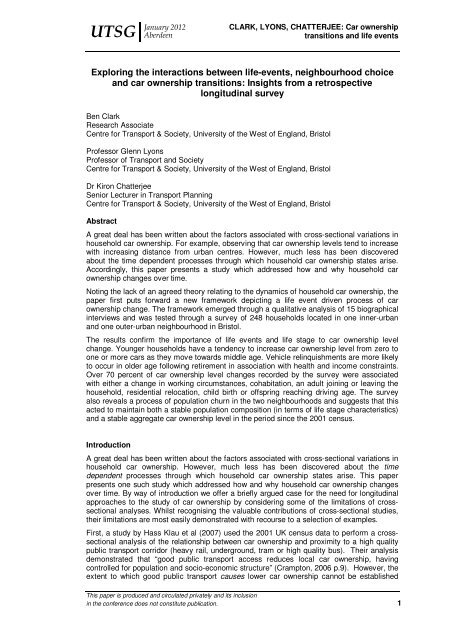Clark, B., Lyons, G. and Chatterjee, K. (2012) - UWE Research ...
Clark, B., Lyons, G. and Chatterjee, K. (2012) - UWE Research ...
Clark, B., Lyons, G. and Chatterjee, K. (2012) - UWE Research ...
Create successful ePaper yourself
Turn your PDF publications into a flip-book with our unique Google optimized e-Paper software.
UTSG<br />
January <strong>2012</strong><br />
Aberdeen<br />
CLARK, LYONS, CHATTERJEE: Car ownership<br />
transitions <strong>and</strong> life events<br />
Exploring the interactions between life-events, neighbourhood choice<br />
<strong>and</strong> car ownership transitions: Insights from a retrospective<br />
longitudinal survey<br />
Ben <strong>Clark</strong><br />
<strong>Research</strong> Associate<br />
Centre for Transport & Society, University of the West of Engl<strong>and</strong>, Bristol<br />
Professor Glenn <strong>Lyons</strong><br />
Professor of Transport <strong>and</strong> Society<br />
Centre for Transport & Society, University of the West of Engl<strong>and</strong>, Bristol<br />
Dr Kiron <strong>Chatterjee</strong><br />
Senior Lecturer in Transport Planning<br />
Centre for Transport & Society, University of the West of Engl<strong>and</strong>, Bristol<br />
Abstract<br />
A great deal has been written about the factors associated with cross-sectional variations in<br />
household car ownership. For example, observing that car ownership levels tend to increase<br />
with increasing distance from urban centres. However, much less has been discovered<br />
about the time dependent processes through which household car ownership states arise.<br />
Accordingly, this paper presents a study which addressed how <strong>and</strong> why household car<br />
ownership changes over time.<br />
Noting the lack of an agreed theory relating to the dynamics of household car ownership, the<br />
paper first puts forward a new framework depicting a life event driven process of car<br />
ownership change. The framework emerged through a qualitative analysis of 15 biographical<br />
interviews <strong>and</strong> was tested through a survey of 248 households located in one inner-urban<br />
<strong>and</strong> one outer-urban neighbourhood in Bristol.<br />
The results confirm the importance of life events <strong>and</strong> life stage to car ownership level<br />
change. Younger households have a tendency to increase car ownership level from zero to<br />
one or more cars as they move towards middle age. Vehicle relinquishments are more likely<br />
to occur in older age following retirement in association with health <strong>and</strong> income constraints.<br />
Over 70 percent of car ownership level changes recorded by the survey were associated<br />
with either a change in working circumstances, cohabitation, an adult joining or leaving the<br />
household, residential relocation, child birth or offspring reaching driving age. The survey<br />
also reveals a process of population churn in the two neighbourhoods <strong>and</strong> suggests that this<br />
acted to maintain both a stable population composition (in terms of life stage characteristics)<br />
<strong>and</strong> a stable aggregate car ownership level in the period since the 2001 census.<br />
Introduction<br />
A great deal has been written about the factors associated with cross-sectional variations in<br />
household car ownership. However, much less has been discovered about the time<br />
dependent processes through which household car ownership states arise. This paper<br />
presents one such study which addressed how <strong>and</strong> why household car ownership changes<br />
over time. By way of introduction we offer a briefly argued case for the need for longitudinal<br />
approaches to the study of car ownership by considering some of the limitations of crosssectional<br />
analyses. Whilst recognising the valuable contributions of cross-sectional studies,<br />
their limitations are most easily demonstrated with recourse to a selection of examples.<br />
First, a study by Hass Klau et al (2007) used the 2001 UK census data to perform a crosssectional<br />
analysis of the relationship between car ownership <strong>and</strong> proximity to a high quality<br />
public transport corridor (heavy rail, underground, tram or high quality bus). Their analysis<br />
demonstrated that “good public transport access reduces local car ownership, having<br />
controlled for population <strong>and</strong> socio-economic structure” (Crampton, 2006 p.9). However, the<br />
extent to which good public transport causes lower car ownership cannot be established<br />
This paper is produced <strong>and</strong> circulated privately <strong>and</strong> its inclusion<br />
in the conference does not constitute publication. 1

















